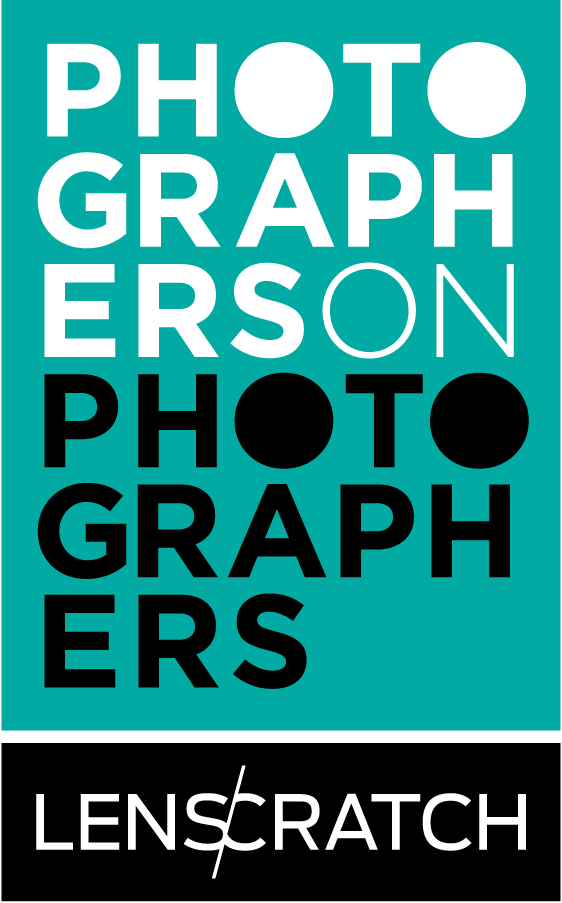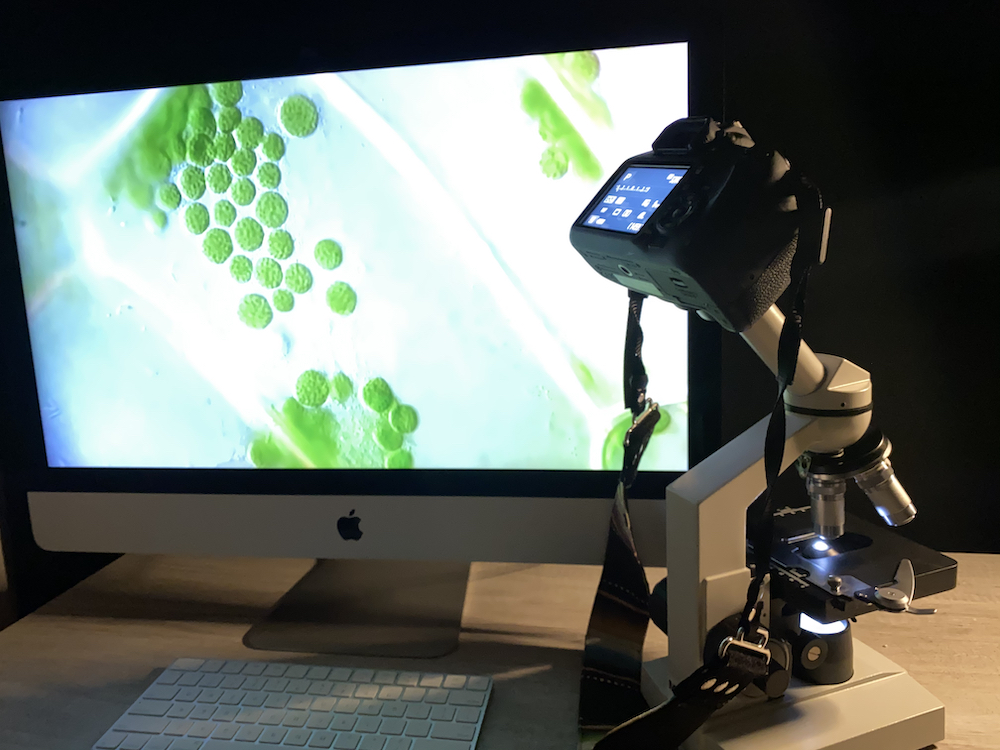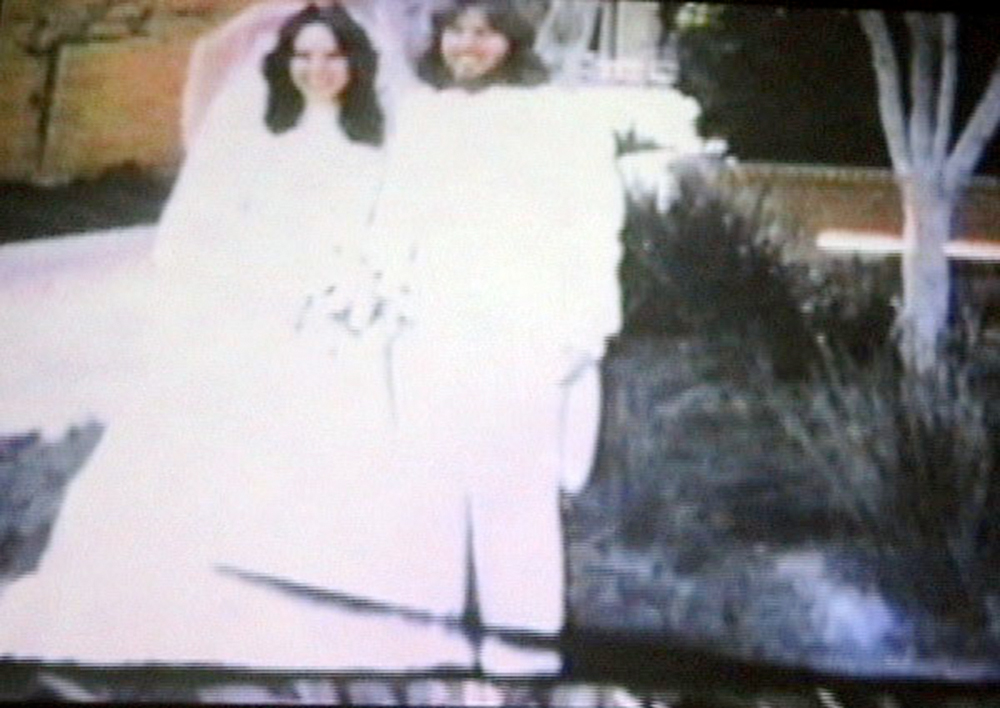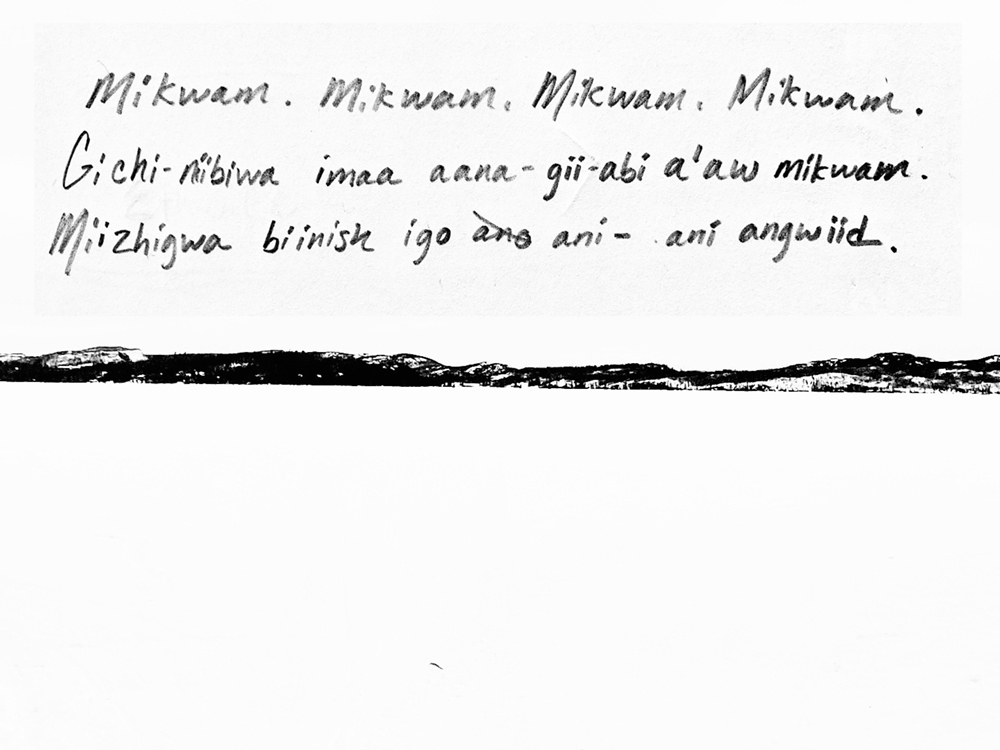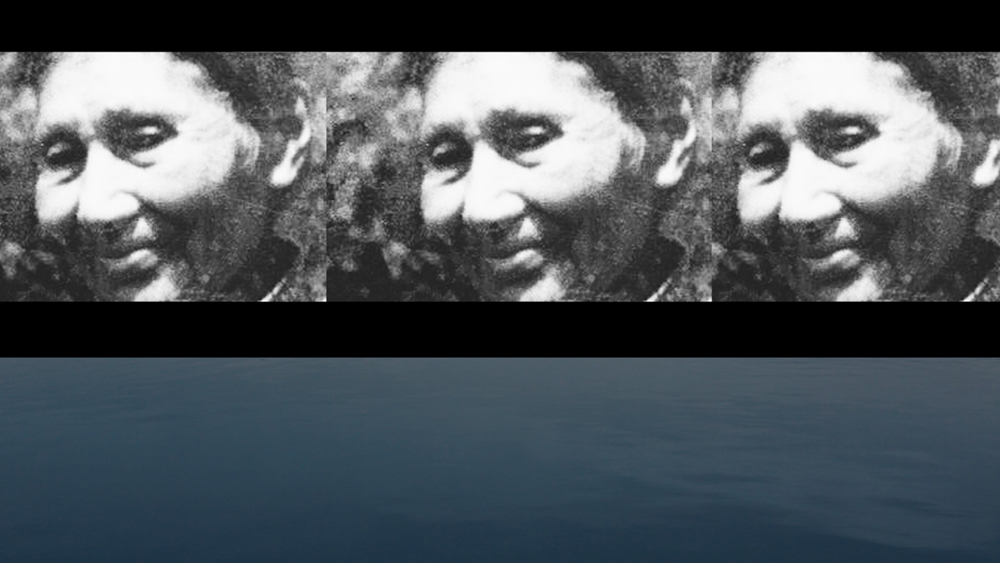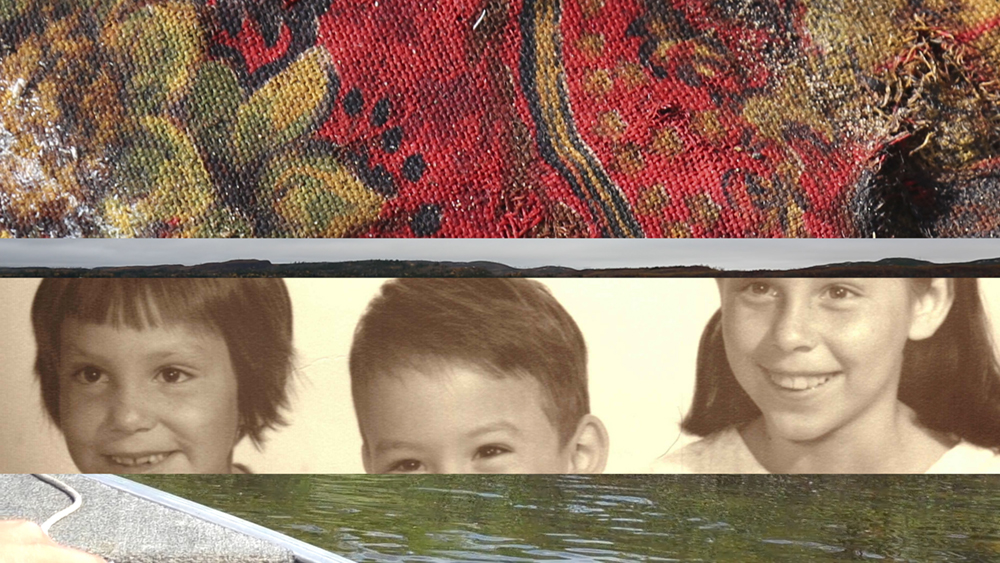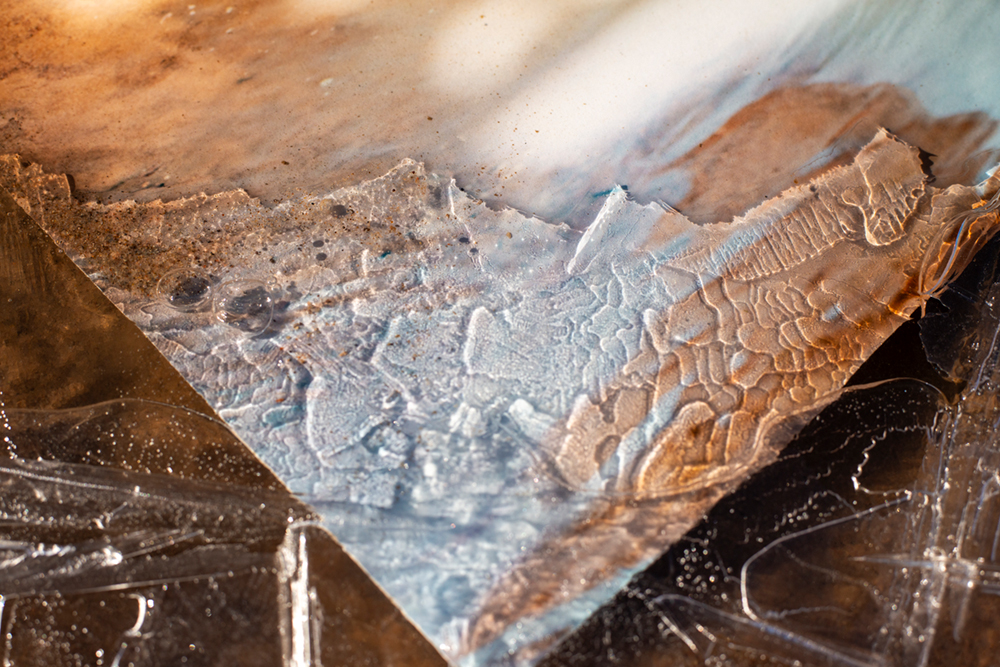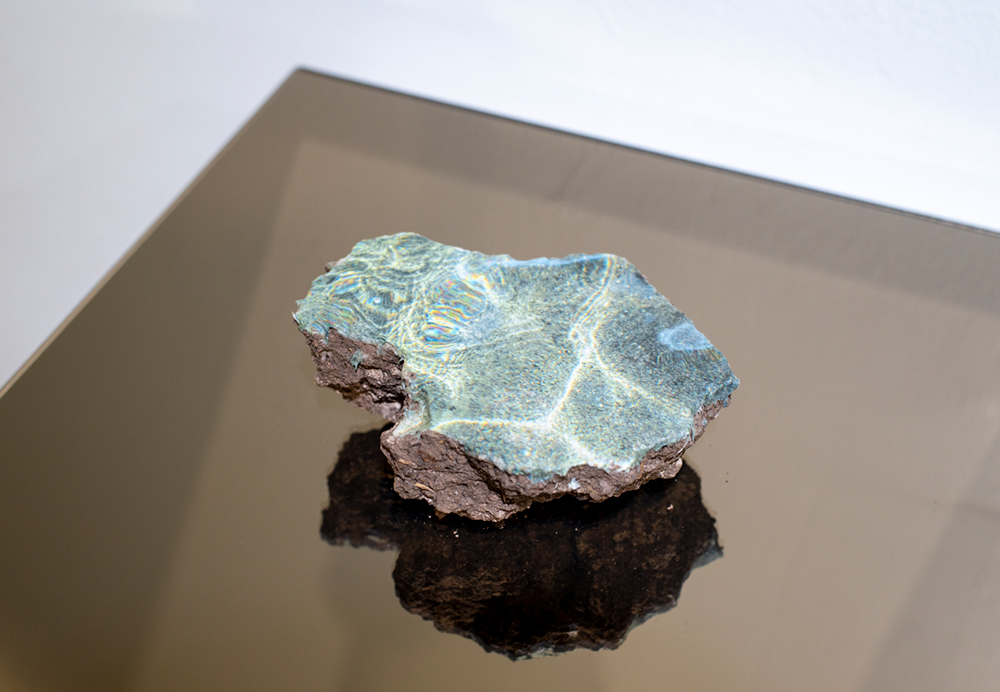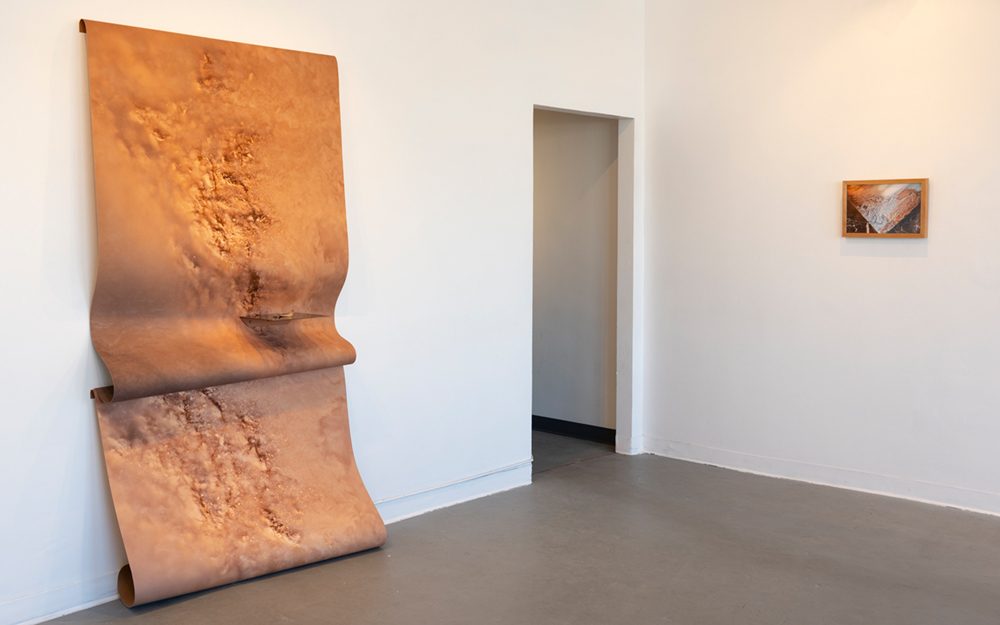Photographers on Photographers: Anna Rotty in Conversation with Marcella Ernest
Over the last three years I’ve had the privilege of working with Marcella Ernest (Marcella Kwe) as a graduate student at the University of New Mexico. Marcella is someone who I admire on so many levels. As a mentor and educator, she has a way of challenging people to think critically with kindness and humor. My own experience as an artist is significantly shaped by her generosity as a teacher. As an art historian and experimental filmmaker, Marcella’s work helps us consider the impact that photographs have, where they come from and how they might be remixed and recontextualized to say something more. As an artist, Marcella dives deep into the complexities of family, memory, land, and swims in what Dian Million describes as Felt Theory, focusing on affect and making the personal political.
It’s hard to find all the words that embody Marcella’s unique practice as an interdisciplinary artist. Her work challenges us to expand our own ways of seeing, feeling, and understanding photographs and visual culture. She makes, and teaches, with reciprocity and collaboration at the forefront of her work. As photographers we often place an emphasis on the final image or series. Marcella’s work transcends this idea that a photograph is fixed. Her work reminds us that photographs are an evolving and haptic experience, diving into archives, maps, and creating films that explore still images through the senses, using sound and storytelling to share her unique experiences. I’m grateful to have had the opportunity to work with her as I consider what it means to make photographs, and the ways in which we share our experiences through photography.
Marcella Ernest is an Assistant Professor of Native American Art History at the University of New Mexico and an interdisciplinary artist best known for creating experimental sound, photography, and video art. Her research explores the varying relationships between abstract expressions, sound studies, remix culture, and Native feminisms. Marcella is Gunflint Lake Ojibwe and an enrolled member of the Bad River Band of Lake Superior.
Instagram: @ marcellakwe
Anna Rotty: Marcella, thanks for taking the time to speak with me. When I was presented with the chance to interview a photographer for this series you immediately came to mind because you are someone who has shaped how I, and I know many others, look at and make photographs, through your influential work as a professor at the University of New Mexico, and through your personal work that I’ve been lucky to experience. It occurred to me though, do you consider yourself a photographer? How do you define your art practice?
Marcella Ernest: I’ll have to think about that. I often don’t know what to call my art practice. I have a lens-based art practice that includes mostly film and digital video and photography. I use a lot of super eight millimeter film and 16 millimeter found footage. The super eight either comes from my own family’s archive or stuff that I shoot. So that’s what I mean by film. With video, I haven’t, for a long time, used video cameras. I usually use photographs and then put them into a video based platform for editing. Beyond just the image alone, I always make my own (video) transitions and color filters by making light and color with still photography or film cameras. I use those lights and colors as collage-like layers on top of either moving images or still photography.
Anna Rotty: Oh, I love hearing about that process. It’s clear photographs and imagery are a significant part of your work, but the “taking” of an image is secondary to how you are arranging them all together to share a story, it sounds. How did you first get into this?
Marcella Ernest: I did my master’s degree at the University of Washington in Seattle, and they had a program that was called Native Voices. It was a three year master’s program specifically for Native American or Indigenous communities studying documentary arts. We were trained just like any documentary film making program, so a lot of cameras and lenses and angles and shots, but it was more about how you use images and research to tell a story. So the emphasis, and probably because it was a Native based and research methods program, was really based in storytelling and relationships. The camera and the technology was sort of an afterthought to story and research. In that program, I started using more still photography than I had in the past because it was more accessible to me. We had access to all kinds of cameras and gear and training, but the still camera was easiest for me to not be intrusive to communities and cultural goings ons, or when interviewing elders. Mixing that University training of storytelling and documentary with an arts practice is when I started a process of making experimental documentary films.
Anna: That’s interesting. I’ve always wanted to know more about your process and how you work, because I know that you are very considerate, and perhaps sometimes critical, would you say, about photography as a historic medium. The first time I saw your experimental documentary films and your work with remix, as you call it, was your Blood Memory series, screened in a Native Film class taught by Dr. Jennifer Denetdale at the University of New Mexico. I really enjoyed watching those, and hearing and feeling them. I remember your family photographs, repetition of sounds, and Madonna’s music. These films resonate in the way that a memory does. How did that come to be?
Marcella: Yes, those films are Blood Memory, and then there’s Blood (and) Memory2. The “part 2” of Blood (and) Memory2 is a citation mark, whereas the 2 is a footnote, because it’s the title of an essay by Chadwick Allen. Nancy Mithlo was curating a show at the Museum of Contemporary Native Art in Santa Fe. She commissioned the first piece, specifically on this concept of blood memory. To explain, and generalize, it is talking about memory and how memory operates and how it almost becomes embedded into our DNA. It derives from the 1968 novel, House Made of Dawn, from N. Scott Momaday. I was introduced to the concept by Gerald Vizenor. So an opportunity to create a piece for this was a very inspiring opportunity for me. I love being given a theme or a concept. For that piece, the whole thing is remixed, if you will, of super eight millimeter film footage that my dad had taken over the course of however many years. My dad is a photographer and is always carrying around a camera to this day. He has boxes of super eight millimeter film from when he was a teenager to his twenties. Later it gets into VHS. But all of that super eight film and VHS in both Blood Memory pieces is his old footage.
I was using video cameras and still cameras since I was probably six years old. I would borrow the VHS camera. That’s what we did for sleepovers and for fun, was make movies and take pictures. And then my dad would have them developed and we would go ride our bikes and pick up our film, our pictures, and we would hang them up, or I would put them through the Xerox machine at his office. I still do that. But anyway, the Blood Memory pieces are his footage remixed. Ten years after the first one, the Smithsonian National Museum of American Indian asked me to revisit blood memory.
Two from Marcella Kwe on Vimeo.
Anna: What was that like returning to that work?
Marcella: I went back into the family archive, and was like, okay, so what was the next iteration, technology-wise? After super eight he turns to VHS. The first one, the super eights, I’m in it, but I’m like one year old, two years old. I am a little baby. In the return to Blood (and) Memory2, it felt natural to follow the era through the recording technology and mess around with his VHS tapes. It was a lot of going back and looking at VHS, and now I’m like 11, 12, something like that. Again, all of it is remixed footage from the VHS.
So when you’re talking about Madonna’s music, that’s interesting, because it wasn’t something that you heard, it was something you saw. It is VHS footage of my brother’s birthday party, and then all of a sudden there’s Madonna performing at the VMA awards. It just means that I wanted to record her performance, and I didn’t care what was on that VHS, because I am 11 years old, so I recorded it over my brother’s birthday. So then you get 10 minutes of this Madonna performance, and then it goes back to my brother’s birthday party. There’s tons of that. It’s like Christmas morning, and then all of a sudden there’s Greystoke: The Legend of Tarzan. So that second Blood Memory is VHS era and it definitely has a different sound. I was building a sonic representation of the nineties VHS era, in my home. It’s all about how to articulate visually and sonically that era of time and memory. Maybe in 10 more years I will revisit it again with my mini DV tapes.
Anna: I’d love to see that. And that’s so relatable, coming across these fragmented moments of VHS recording from that era. Pop culture getting mixed up with family milestones, etc. So you have this documentary background with Native Voices, and currently make experimental films, and you have your PHD in American Studies, and now you teach in Art History, but you’re also an artist, and a lot of people who you teach in art history both do, and do not, (which is sort of strange) make art. Do you feel like all of these different fields that you’ve studied impact your teaching and your own artwork and research in different ways?
Marcella: That is a good question. Yes, it makes me approach things differently in my teaching Art History. The thing you said about “it’s strange”, was your word, that art historians don’t typically have an art practice. Typically, if you are going to study photography, for example, through art history, you’re not required to take an intro to photography class where you are actually making pictures. I think you should be. If you think about it, it is fascinating that you could make a career talking about something, but not be required to experience actually making it. To be more clear on your question though, making art definitely changes the ways I approach teaching about art, and having a PhD has shifted the ways I make art. For example, I am a researcher. An academic researcher. That has created a more theoretical and research based approach to my own art practice. I apply that to MFA students’ I work with. In similar ways, I encourage Art History students to think through their research in creative ways also. Make a zine, write a song, do a performance. There are other ways to approach Academia more broadly and Art History more specifically, beyond just writing papers.
Three from Marcella Kwe on Vimeo.
Anna: Yes, well this reminds me of something that we’ve talked about in your classes, specifically in your Visual Sovereignty and the Archive class, about the hierarchy of knowledge. In Western societies, written knowledge is typically the most valued, visual comes next, and then we’ve talked about how sound can often be overlooked, even ignored. I’m curious to hear your thoughts on sound. Do you think about the classes that you teach in relation to how you also operate as an artist or an art historian, or a person who thinks about all of these things and all of their implications in the world?
Marcella: I am a professor in art history with a PhD in American Studies, but also a practicing artist. So, what is my work? Is it written work? Is it a book I’m working on? Is it teaching or is it more of a making art practice? It took me a long time to be comfortable saying, well, it’s all of it. In so many ways, teaching is art to me, especially because it brings in so much about performance and performing arts. I started thinking about something like a PowerPoint as a storytelling platform, and that changed the way that I use PowerPoint in the classroom. Because as an artist, I am seeing that platform in a different way, and it’s helpful, but then is that PowerPoint-making part of my art practice? I think so, because you’re telling a story and disseminating and sharing knowledge and asking more questions than having answers and engaging in a dialogue and a discussion. I would say that my work is primarily lens-based and sound, and sometimes performance, and sometimes the latter includes installation or sculptural elements. And then it also includes research and writing and teaching. So that’s my work.
Anna: A very holistic perspective. Two things I know you’re passionate about are sound and remix. How do those two things come up in your work?
Marcella: I wrote my dissertation on sound and remix art, particularly photography and how photography has been and continues to be a tool of colonialism. We tend to think about settler colonialism in the United States, and then we start talking about the Indian wars and guns and battlefields. But there’s also the camera, which is very present throughout history, sort of leading the way and developing a narrative of who Native people were in the United States. And through the photographic form, it was used as a very deceptive tool to manipulate public opinion about Indian people and land. And I could argue that it still works like that today.
The remix part of it is looking at how contemporary Native American artists take those archival images, and rework them into something new to tell a different story. So not abandoning them completely, but thinking about how they are taking photography and film and making new works from something old to tell the story differently, to imagine otherwise? That’s the remix part. The sound element is more of a theoretical thinking through sound, not about sound. So thinking through sound as a vibration or thinking through sound as something that we experience in our bodies, and not dismissing it as part of Art and History. I ask, what does decolonization sound like? To elevate our understanding of what we want in these anti-colonial movements. A few artists that I think do that well are Sarah Sense (Choctaw/Chitimacha), Sarah Biscarra Dilley (Northern Chumash tribe) and Nicholas Galanin (Tlingit-Unangax̂).
In my art practice, sound is really important. It’s probably the first thing that I do, after research, in terms of process. How is it going to sound? What sounds do I need to collect? I build a sound piece first, and then I add the images over it. I try to think about, oh, what camera matches this or what images can I use to illustrate this sound ?
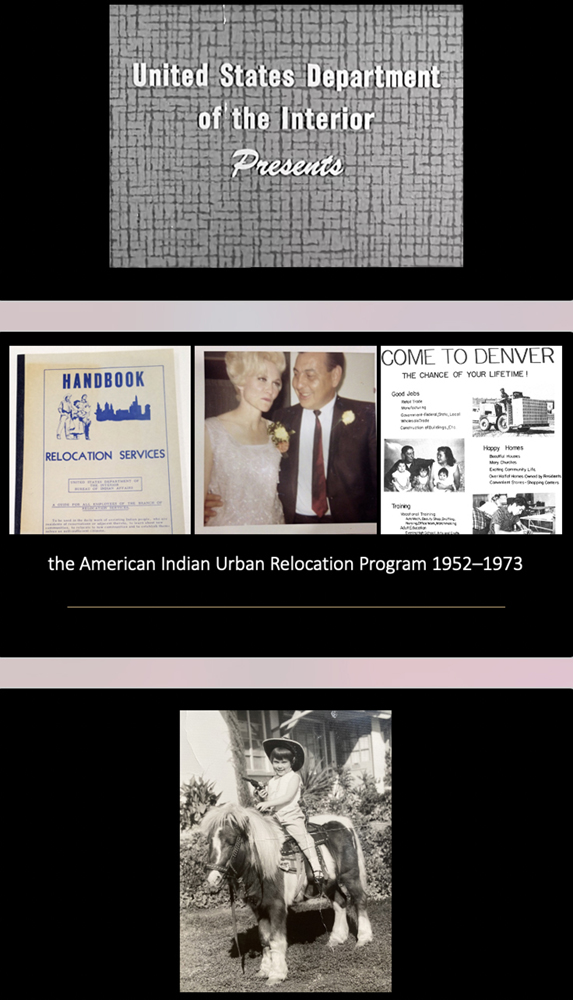
© Marcella Ernest, Across the Lake, still from powerpoint slide portion of performative lecture presentation, Albuquerque Museum, 2024
Anna: I didn’t realize that the sound comes first in your work. Quite different from how we were speaking about that hierarchy of knowledge. I’m tempted to share links to you speaking and to your sound work here so the readers can associate in that way. I think about how sound, or to quote Tina Campt, “listening to images”, can add context to the imagery we see in your experimental film work.
Marcella: I think about Why and How context becomes important to the way we understand things. Sometimes a picture can exist as just a picture and it’s aesthetically really pleasing. But then there’s all this context too that sort of exists in these realms of the unseen, which always for me lends itself to sound studies and what exists outside of the frame. Thinking about the histories, the time period, the people, race, class, gender, that’s the context. When was this picture taken? Where was it? And then doing that work to go deeper and find out what was happening at that place at that time. I think a lot of archival images exist in this layer of irony.
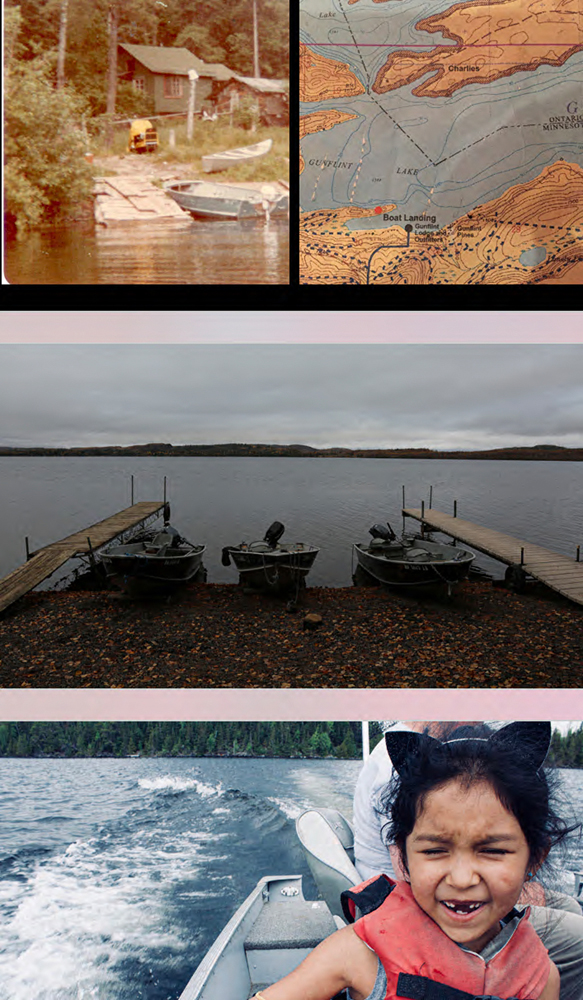
© Marcella Ernest, Across the Lake, still from powerpoint slide portion of performative lecture presentation, Albuquerque Museum, 2024
Anna: I encourage people to watch your videos and listen carefully to the sound. That’s a good segue to my next topic. I wanted to ask about your project Across the Lake. I guess I called it a project because maybe it is considered a film, but I got the chance to hear you contextualize the film in what might be called a “performance”. This is another example of how your work sort of transcends genre. You had presented the piece at the Albuquerque Museum this spring and I personally felt like it was extremely effective as a way to talk about the complexities of images. You had your mom and siblings on the phone, sort of chiming in to contextualize the film. I’m curious why you presented it in that way. Could you tell us about this piece?
Marcella: I would agree with you, Across the Lake is performative on so many levels, and I honestly did not conceptualize it to be that way, it just sort of organically happened. So why is it a performance? It’s a performance because it’s a film, we’ll call it an experimental documentary film, that’s 11 minutes in length that’s embedded into a PowerPoint. And I’ve already talked about how I am thinking more and more about how a PowerPoint becomes a platform for storytelling. So it is an 11 minute film that is embedded within a feature length time frame. So it has film, photography, sound, and then a live presentation that is a narrative performance of the story. It is performative because I’m standing on a stage and I’m talking, and I’m going through what would customarily be called, a slideshow of photography and newspaper clippings and archives with photographs that are new, and I’m narrating a story that leads us to this 11 minute film. And then I continue the story for maybe another 15 minutes or so.
In the beginning, there are maps to position where the story takes place geographically and to present the disenfranchisement of the US Canadian border lands, and there are archival elements to see the written complexities within US policy and law. The slide presentation works to set that up in more of a performative lecture format, because that information isn’t in the film. It’s more expressed in the film than it is narrated. So then that’s how it becomes this sort of photo lecture, or performative, feeling story. The piece is different every time I’ve done it. The film stays the same, but the presentation of it, the dialogue and sometimes the pictures. The audience plays a huge part in that change. For example, if I did that in Minnesota, it would be very different from how I do it in Albuquerque.
Anna: That makes me think back to the “unseen” and what’s inside the frame of a photograph, or not. When are we hearing from the artist directly? Context and process are important aspects of your work, that also are the work itself, as seen by the viewer. I feel like that’s really effective and important.
Marcella: A lot of my work in particular is about the process and the context, even if I’m going to talk about teaching. My teaching methodologies are about the process and relationships, and that doesn’t mean that I am going to have 50 students and have 50 relationships with 50 students. That’s just not how relationships work. But my goal is for them to either have relationships with each other and with me, or even just with themselves in ways that are meaningful and feel safe in terms of space and safe in terms of speaking. But really their job is to learn and ask questions and experience things and feel inspired. And I think that elements of our jobs, as professors, should be the same thing. We should also be learning and asking questions and feeling inspired. I see a lot of that process in my artwork too.
Anna: In addition to teaching college students, you also work with youth in photography and film through the Lensic Future Voices program. What sort of questions are young photography and film students asking?
Marcella: I’ve done that for a really long time. Technology has changed so much in the last 10, 20 years, so we don’t necessarily have to do a lot of technical trainings anymore with them. In my experience, 10 years ago, kids were showing up and they don’t know how to turn on the camera. They don’t know about White Balance. They don’t know about ISO. They don’t know about the lens and the focusing. Now, they all have a camera and movie making abilities in their pocket, and they are showing up with advanced editing skills from working in platforms like TikTok and Capcut on their phones. Now, their technology is more advanced, but their storytelling is weakening. They are faster. They are quicker. They don’t want to take the time to tell a story though. Whereas in the past, it was the opposite.
Anna: Yeah, it seems that they (and us adult artists too, because it’s hard not to go there) are thinking about what the end result is going to be, and that’s shaping their process and their thinking around it.
Marcella: Yes, absolutely.
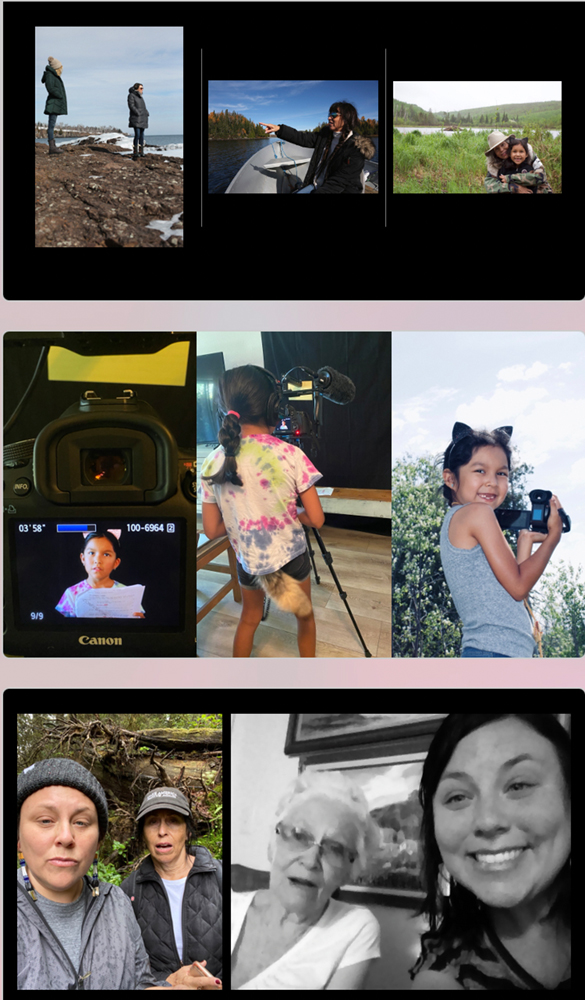
© Marcella Ernest, Across the Lake, still from powerpoint slide portion of performative lecture presentation, Albuquerque Museum, 2024
Anna: I’m thinking about the relationship between thinking critically and thinking creatively. This is something that’s come up in class. You emphasize asking good questions. With telling stories, even if it’s a personal story, the amount of time we invest in the process is shifting. And maybe that’s because we’re expected to produce so often, or the technology is allowing us to produce so much so fast. It’s clear in your work, like Across the Lake for example, that the level of research and layers are evident. It’s obvious that it didn’t just pop out of a brief amount of time. I’m curious what you’re working on right now. Are you deep in the research and making, or where are you at?
Marcella: I don’t know. I feel very inspired by one person and our relationship right now, and ideas of decolonial love. That is always a good thing for an artist. I’m working on a book that’s called Remixing the Archive. That is always a good thing for a professor. I just finished a piece called gichi-ginebigoog gaye binesiwag, about Anishinaabe Thunderbirds and Serpents. It was commissioned and curated by Lois Taylor Biggs (Cherokee Nation/White Earth Ojibwe). Lois is a Chicago-based writer, curator, and art historian. That just opened in Chicago, at the Center for Native Futures, and it’ll be up until December. That is an all Anishinaabe show called Gagizhibaajiwan. It is a huge honor to be in a show like that. A dream. I built an environment for listening. I vinyl printed serpents that my daughter designed, so the serpents are black with some gray markings, and they go on color treated walls that are very dark gray. They almost look black, and then you’re just kind of immersed in this sound piece that’s telling Anishinaabe cultural teachings of the serpent. It has a small video projection component that is 49 seconds of ice that repeats and repeats and repeats.
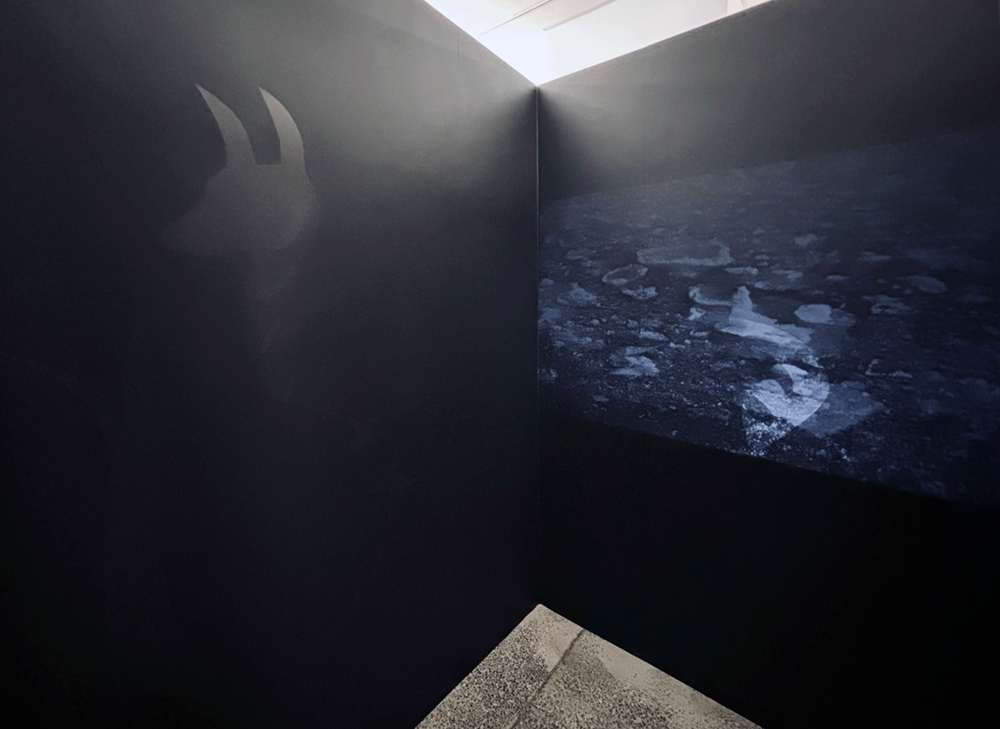
© Marcella Ernest, gichi-ginebigoog gaye binesiwag, installation view of exhibition titled Gagizhibaajiwan, curated by Lois Taylor Biggs (Cherokee Nation/White Earth Ojibwe), Center for Native Futures, Chicago, IL, 2024
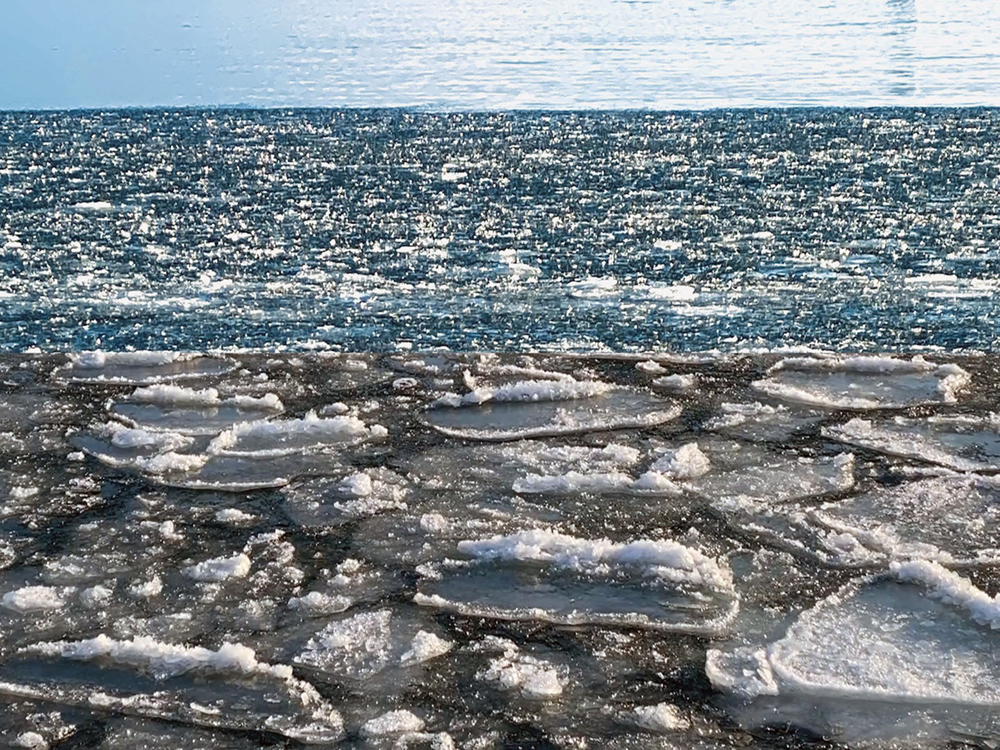
© Marcella Ernest, gichi-ginebigoog gaye binesiwag, still from video included in exhibition titled Gagizhibaajiwan, curated by Lois Taylor Biggs (Cherokee Nation/White Earth Ojibwe), Center for Native Futures, Chicago, IL, 2024
Anna: Again, that repetition is so powerful in your work, with both images and sound. I feel like I’m always telling people, “you have to take a class with Marcella”, because everything is amazing and interesting and important. I think it’s effective for me as a learner and artist, because you’re funny and you’re great to listen to and talk to and have a conversation with. You find a way to talk about these things that are layered and complicated from many different directions and angles. And I think that’s how we should be looking at things and talking about things as artists. Our systems don’t always account for that. So I appreciate it. Thank you for sharing so much of your work and your practice with us. I hope people get the chance to see, hear, and feel your work in person as I’ve been fortunate enough to do. Thank you Marcella!
Marcella: Thank You Anna. As for teaching, you are very kind, thanks. Something I learned is that we can have 20 students, and that means there are 20 different ways of learning in the room. We can’t match with everyone in ways that are effective. I am glad that it worked for you. I am genuinely grateful for your art and your presence, always.
Anna Rotty lives on Tiwa land in Albuquerque. She earned her MFA in 2024, and currently teaches, at the University of New Mexico. Anna received a BFA from the University of Massachusetts Amherst in 2011. Her work investigates water, light and infrastructure, informing her understanding of orientation and place. Her work has been published by Southwest Contemporary, Humble Arts Foundation, and Lenscratch, where she earned 3rd place in the Student Portfolio Prize in 2023.
Instagram: @ annarotty
Posts on Lenscratch may not be reproduced without the permission of the Lenscratch staff and the photographer.
Recommended
-
Salua Ares: Absense as FormNovember 29th, 2025
-
Ricardo Miguel Hernández: When the memory turns to dust and Beyond PainNovember 28th, 2025
-
Pamela Landau Connolly: Columbus DriveNovember 26th, 2025
-
KELIY ANDERSON-STALEY: Wilderness No longer at the Edge of ThingsNovember 19th, 2025
-
Jackie Mulder: Thought TrailsNovember 18th, 2025


